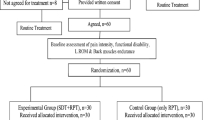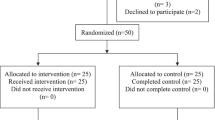Abstract
Purpose
Chronic low back pain and lumbar spinal stenosis (LSS) seem to deteriorate lumbar muscle function and proprioception but the effect of surgery on them remains unclear. This study evaluates the effect of decompressive surgery on lumbar movement perception and paraspinal and biceps brachii (BB) muscle responses during sudden upper limb loading in LSS.
Methods
Low back and radicular pain intensity (VAS) and Oswestry Disability Index (ODI) were measured together with lumbar proprioception and paraspinal and BB muscle responses prior to and 3 and 24 months after surgery in 30 LSS patients. Lumbar proprioception was assessed by a previously validated motorized trunk rotation unit and muscle responses for sudden upper limb loading by surface EMG.
Results
Lumbar perception threshold improved after surgery during 3-month follow-up (from 4.6° to 3.1°, P = 0.015) but tend to deteriorate again during 24 months (4.0°, P = 0.227). Preparatory paraspinal and BB muscle responses prior to sudden load as well as paraspinal muscle activation latencies after the load remained unchanged.
Conclusion
Impaired lumbar proprioception seems to improve shortly after decompressive surgery but tends to deteriorate again with longer follow-up despite the sustaining favorable clinical outcome. The surgery did not affect either the feed-forward or the feed-back muscle function, which indicates that the abnormal muscle activity in LSS is at least partly irreversible.



Similar content being viewed by others
References
McGregor AH, Probyn K, Cro S et al (2013) Rehabilitation following surgery for lumbar spinal stenosis. Cochrane Database Syst Rev 12:CD009644
Beck AT, Ward CH, Mendelson M et al (1961) An inventory for measuring depression. Arch Gen Psychiatry 4:53–63
Cholewicki J, Silfies SP, Shah RA et al (2005) Delayed trunk muscle reflex responses increase the risk of low back injuries. Spine 30:2614–2620
Dubourg G, Rozenberg S, Fautrel B et al (2002) A pilot study on the recovery from paresis after lumbar disc herniation. Spine 27:1426–1431
Fairbank JCT, Couper J, Davies J, O’Brien JP (1980) The Oswestry low back pain disability questionnaire. Physiotherapy 66:271–273
Hodges P, Cresswell A, Thorstensson A (1999) Preparatory trunk motion accompanies rapid upper limb movement. Exp Brain Res 124:69–79
Hodges PW, Moseley GL, Gabrielsson A, Gandevia SC (2003) Experimental muscle pain changes feedforward postural responses of the trunk muscles. Exp Brain Res 151:262–271
Khan SI, McNeil CJ, Gandevia SC, Taylor JL (2011) Effect of experimental muscle pain on maximal voluntary activation of human biceps brachii muscle. J Appl Physiol 111(3):743–750
Kääriäinen T, Leinonen V, Taimela S et al (2013) Lumbar paraspinal and biceps brachii muscle function and movement perception in lumbar spinal stenosis. Eur Spine J 22(4):788–793
Leinonen V, Airaksinen M, Taimela S et al (2007) Low back pain suppresses preparatory and triggered upper limb loading. Spine 32:E150–E155
Leinonen V, Kankaanpää M, Luukkonen M et al (2003) Lumbar paraspinal muscle function, perception of lumbar position and postural control in disc herniation-related back pain. Spine 28:842–848
Leinonen V, Kankaanpaa M, Luukkonen M et al (2001) Disc herniation-related back pain impairs feed-forward control of paraspinal muscles. Spine 26:E367–E372
Luoto S, Taimela S, Hurri H et al (1996) Psychomotor speed and postural control in chronic low-back pain patients: a controlled follow-up study. Spine 21:2621–2627
Moseley GL, Hodges PW, Gandevia SC (2003) External perturbation of the trunk in standing humans differentially activates components of the medial back muscles. J Physiol 547:581–587
Strutton PH, Catley M, McGregor AH, Davey NJ (2003) Corticospinal exicitability in patients with unilateral sciatica. Neurosci Lett 353:33–36
Taimela S, Kankaanpää M, Luoto S (1999) The effect of lumbar fatique on the ability to sense a change in lumbar position—a controlled study in chronic LBP patients and healthy controls. Spine 24:1322–1327
Chiou S, Shih Y, Chou L et al (2014) Impaired neural drive in patients with low back pain. Eur J Spine 18:794–802
Conflict of interest
None.
Author information
Authors and Affiliations
Corresponding author
Rights and permissions
About this article
Cite this article
Kääriäinen, T., Taimela, S., Aalto, T. et al. The effect of decompressive surgery on lumbar paraspinal and biceps brachii muscle function and movement perception in lumbar spinal stenosis: a 2-year follow-up. Eur Spine J 25, 789–794 (2016). https://doi.org/10.1007/s00586-015-4036-5
Received:
Revised:
Accepted:
Published:
Issue Date:
DOI: https://doi.org/10.1007/s00586-015-4036-5




